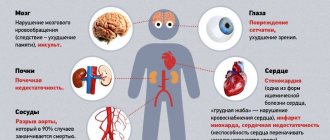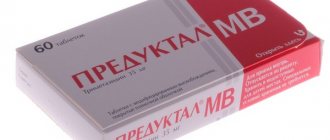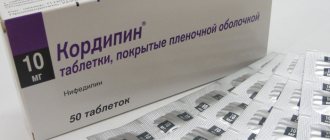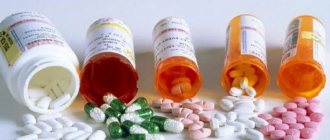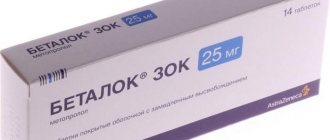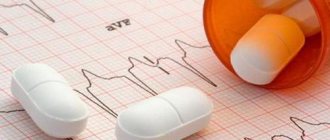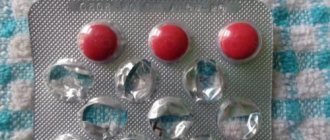Release form and composition
Metoprolol tablets have a round shape, a biconvex surface, and depending on the dosage, they can have a pinkish (50 mg) or light yellow (100 mg) color. The main active ingredient of the drug is metoprolol tartrate, its content in one tablet is 50 or 100 mg. It also includes auxiliary components:
- Titanium dioxide.
- Talc.
- Hypromellose.
- Polysorbate 80.
- Crimson dye (Ponceau 4R).
Metoprolol tablets are packaged in blister packs of 10 and 14 pieces. The cardboard pack contains 2, 3 and 4 blisters with the corresponding number of tablets, as well as instructions for use of the drug.
Composition of the medicinal product
The drug is available in three forms of release:
- Metoprolol is a fat-soluble beta-blocker, used as tartrate and succinate salts. This form increases the speed of delivery to blood vessels. The type of salt and production methods determine the duration of the clinical effect of the drug;
- Metoprolol succinate is a retard form with a long-term supply of the active substance; the therapeutic result of the drug lasts more than a day. Succinate is a long-acting pharmaceutical form. In addition, Metoprolol succinate tablets reduce the risk of fatigue and bradycardia and have a positive effect on bronchial smooth muscle tissue;
- Metoprolol tartrate is a standardized form of release of the drug. The duration of its therapeutic effect is 12 hours. The medication is a fast-acting drug. There are also forms with periodic release.
pharmachologic effect
Metoprolol tartrate, which is the main active ingredient of the drug, blocks b1-adrenergic receptors localized in the heart and arterial vessels. It has no intrinsic sympathetic influence, so it has several therapeutic effects, which include:
- Hypotensive effect - reduces the level of systemic blood pressure by reducing heart rate, cardiac output and spasm of arterial vessels (expansion of the lumen due to relaxation of the smooth muscles of the arterial walls).
- Antianginal effect - realized by reducing heart rate and reducing the need of the myocardium (heart muscle) for oxygen and nutritional compounds.
- Antiarrhythmic effect – normalization and reduction of heart rate.
After taking the Metoprolol tablet orally, the active substance is quickly and almost completely absorbed into the blood from the lumen of the gastrointestinal tract. It is evenly distributed in the tissues of the body, metabolized in the liver with the formation of inactive breakdown products, which are excreted in the urine.
Pharmacodynamics and pharmacokinetics
The drug has antiarrhythmic, antianginal and hypotensive effects. The drug does not have internal SMA and does not have a membrane-stabilizing effect.
The hypotensive effect is due to a decrease in the synthesis of renin, monooxygenase, inhibition of the activity of the renin-angiotensin system and the central nervous system. The drug can lower blood pressure during stress and physical exertion at rest.
The antianginal effect is ensured by a decrease in pulse rate, as well as a decrease in the need for oxygen in myocardial tissue. Long-term use of the medication increases exercise tolerance and reduces the severity of angina attacks and their frequency. As a result of eliminating arrhythmogenic factors (arterial hypertension, increased cAMP content, tachycardia, increased activity of the sympathetic nervous system), an antiarrhythmic effect is achieved.
For thyrotoxicosis, heart diseases of functional origin, sinus tachycardia , atrial fibrillation, supraventricular tachycardia, Metoprolol allows you to restore sinus rhythm and reduce heart rate. The drug prevents the formation of migraines.
Average therapeutic dosages of metoprolol, unlike other beta-blockers, have a less pronounced effect on the organs in which beta2-blockers are located (uterus, bronchi, smooth muscle tissue of peripheral arteries, skeletal muscles, pancreas) and on carbohydrate metabolism .
Long-term use of the medication leads to a decrease cholesterol .
What is Metoprolol used for?
Taking Metoprolol tablets is indicated in the complex therapy of cardiovascular pathology, accompanied by an increase in systemic blood pressure and increased load on the heart:
- Treatment of arterial hypertension as monotherapy or in combination with other antihypertensive drugs.
- Complex therapy of coronary heart disease, which is characterized by a decrease in the supply of oxygen and nutrients to the myocardium.
- Therapy of various types of arrhythmia, in particular supraventricular (supraventricular) tachycardia and ventricular extrasystole.
Metoprolol tablets are also used in the complex treatment of hyperthyroidism (increased levels of thyroid hormones, which increases the functional activity of the heart and arterial vessels) and migraines (attacks of severe headaches).
Video on the topic
Research on the effectiveness of Metoprolol:
Metoprolol is a well-proven medicine. The drug has undergone numerous clinical trials in Russia and abroad, and has proven high efficiency and absolute safety when used correctly.
The information on the MyMedNews.ru website is for reference and general information, collected from publicly available sources and cannot serve as a basis for making a decision on the use of medications in the course of treatment.
MyMedNews.ru
And we also have
Treatment with Enalapril - how to take it correctly?
Contraindications for use
Taking Metoprolol tablets is contraindicated in a number of pathological and physiological conditions of the body, which include:
- Individual intolerance to metoprolol tartrate or auxiliary components of the drug.
- Cardiogenic shock is severe heart failure with a critical decrease in its pumping function and the development of multiple organ failure.
- Atrioventricular block of 2-3 degrees is a violation of the passage of the cardiac impulse through the nerve node, which is localized between the atria and ventricles.
- Sick sinus syndrome, characterized by the generation of an impulse in the atrial node of insufficient strength.
- Marked decrease in heart rate (bradycardia).
- Decompensated acute or chronic heart failure.
- Simultaneous administration of verapamil (calcium channel inhibitor) or the use of MAO inhibitors (monoamine oxidase).
- Arterial hypotension (decrease in systemic blood pressure below normal).
- Prinzmetal's angina is a rare form of ischemia (insufficient nutrition and oxygen supply to the heart muscle) of the myocardium, which develops at the early stage of atherosclerotic damage to the coronary (heart) vessels due to their spasm.
- Breast-feeding.
- Children under 18 years of age.
The drug is used with caution for diabetes mellitus, chronic obstructive bronchitis, bronchial asthma (allergic inflammation of the bronchi with their periodic spasm and shortness of breath), 1st degree atrioventricular block, chronic liver or kidney failure, depression, thyrotoxicosis (marked increase in the level of thyroid hormones in the body) , pathology of peripheral vessels with their obliteration (blockage), myasthenia gravis (muscle weakness), pheochromocytoma (hormone-producing tumor of the adrenal glands). Before you start taking Metoclopramide tablets, you should make sure that there are no contraindications.
Interaction
Extracts of allergens used for skin testing, the allergens themselves significantly increase the likelihood of developing anaphylaxis, severe systemic allergic reactions in patients who use Metoprolol.
The risk of developing anaphylactic reactions increases with intravenous administration of radiocontrast drugs based on iodine . Medicines for general inhalation anesthesia, phenytoin when administered intravenously increase the likelihood of a drop in blood pressure and increase the severity of the cardiodepressive effect .
Metoprolol can mask the symptoms of hypoglycemia (high blood pressure, tachycardia ) and change the effectiveness of oral forms of hypoglycemic agents, insulin.
The drug reduces the clearance of xanthines and lidocaine, increasing their concentration in the blood plasma, especially in patients with increased clearance of theophylline with concomitant smoking.
Estrogens, glucocorticosteroids , NSAIDs weaken the hypotensive effect of the drug.
Methyldopa , reserpine, BMCC, cardiac glycosides , antiarrhythmic drugs, amiodarone, diltiazem , Verapamil , guanfacine aggravate the course of bradycardia, heart failure, and atrioventricular block.
When taking nifedipine, there is a significant drop in blood pressure. Hydralazine, sympatholytics, clonidine , diuretics, and other antihypertensive drugs can provoke a sharp and excessive drop in blood pressure.
Metoprolol prolongs the period of anticoagulant effects of coumarins and increases the period of action of non-depolarizing muscle relaxants . Antipsychotic drugs, tetracyclic antidepressants, neuroleptics, tricyclic antidepressants, hypnotics and sedatives, ethanol enhance the inhibitory effect of metoprolol on the central nervous system.
The simultaneous administration of MAO inhibitors is unacceptable due to the risk of a sharp drop in blood pressure.
Impaired peripheral circulation is observed when non-hydrogenated ergot alkaloids are prescribed.
Directions for use and dosage
Metoprolol tablets are taken orally immediately after meals. Do not chew them and wash them down with plenty of water. The regimen and dosage depend on the pathology:
- Arterial hypertension - the initial dosage is 50-100 mg in 1 or 2 doses during the day. If the therapeutic effect is insufficient, the dose may be increased to the maximum therapeutic daily dosage of 200 mg.
- Angina pectoris, arrhythmia or complex treatment of migraine – 100-200 mg per day in 2 doses (morning and evening).
- Functional disorders of the heart, which are accompanied by tachycardia - 100 mg per day, 2 doses (morning and evening).
- Prevention of the development of secondary myocardial infarction – 200 mg per day in 2 divided doses.
For elderly people, there is no need to adjust the dosage. With concomitant liver failure, the dose is reduced depending on the severity of functional liver failure.
Efficacy in hypertension
Metoprolol is an effective hypotensive cardioprotector with antianginal activity.
Improves the prognosis in patients suffering from arterial hypertension, coronary artery disease, and is well tolerated with long-term treatment.
Metoprolol tablets
The hypotensive effect of Metoprolol is explained by a decrease in cardiac output. Thanks to taking the drug, both upper and lower pressure drops, heart rate and supraventricular extrasystoles decrease. The addition of diuretics enhances the antihypertensive effect.
Sudden cessation of taking the drug can provoke a surge in blood pressure, tachycardia, or an attack of angina. Therefore, it is necessary to discontinue the medication within a week, gradually reducing the dosage.
Metoprolol was well tolerated and had a small number of side effects. The reduction in pressure develops progressively and reaches maximum productivity 14 days after the start of therapy.
Side effects
Taking Metoprolol tablets can lead to the development of undesirable reactions from various organs and systems:
- Digestive system - nausea, vomiting, dry mouth, abdominal pain, diarrhea or constipation, decreased functional activity of the liver, impaired taste.
- Cardiovascular system - sinus bradycardia (decreased heart rate), decreased blood pressure, palpitations, orthostatic hypotension (pronounced decrease in blood pressure when changing body position from horizontal to vertical), worsening symptoms of chronic heart failure, development of vasospasm (pronounced reduction walls of arterial vessels, primarily peripheral arteries), arrhythmias, impaired myocardial conduction, pain in the heart area (cardialgia).
- Nervous system - increased fatigue, headache, periodic dizziness, general weakness, depression (long-term decreased mood), paresthesia (impaired skin sensitivity in certain areas of the body), decreased concentration and speed of psychomotor reactions, drowsiness during the day and insomnia at night, nightmares, confusion, memory impairment (especially short-term memory), weakness in skeletal muscles.
- Sense organs – decreased secretion of tear fluid, decreased visual acuity, tinnitus, dry and sore eyes, conjunctivitis (inflammation of the conjunctiva of the eyes).
- Respiratory system – nasal congestion, bronchospasm, which is characterized by difficulty in exhaling, shortness of breath.
- Endocrine system - decreased blood sugar levels (hypoglycemia), especially with the use of insulin, less often there may be an increase in its level, hypothyroidism (decreased functional activity of the thyroid gland and the level of its hormones in the body), weight gain.
- Reproductive system – rarely there may be a decrease in libido, as well as impaired potency in men.
- Skin and subcutaneous tissue - exacerbation of psoriasis (chronic degenerative-dystrophic pathology of the skin), increased sweating (hyperhidrosis), increased photosensitivity of the skin (inflammatory reaction to exposure to light, especially sunlight), reversible alopecia (hair loss).
- Allergic reactions - skin itching and rash on it, urticaria (a characteristic rash that in appearance resembles a nettle burn).
- Laboratory indicators - increased activity of liver transaminase enzymes in the blood (ALT, AST), which indicates damage to hepatocytes (liver cells), a decrease in the number of platelets (thrombocytopenia), leukocytes (leukopenia), hyperbilirubinemia (marked increase in the concentration of bilirubin in the blood) rarely develops. .
If side effects develop, the question of discontinuing the drug is decided by the attending physician, depending on their type and severity.
Additional recommendations
Medical monitoring of the condition of patients who take Metoprolol for a long time according to one or another regimen involves:
- regular measurements of blood pressure, heart rate, blood sugar levels;
- monitoring kidney function (especially when the course of treatment is prescribed to patients over 50 years of age).
- The drug should be discontinued gradually (the initial dose is successively reduced over 10 days).
Medicinal analogues of Metoprolol are:
- Emzok.
- Anepro.
- Betalok.
- Corvitol.
- Vasocardin.
- Metokor.
- Egilok.
special instructions
Before you start taking Metoprolol tablets, you should carefully read the instructions for the drug. There are several special instructions regarding taking the drug that are important to pay attention to:
- Taking Metoprolol tablets requires periodic monitoring of a number of indicators, namely blood pressure, heart rate, blood glucose concentration (in patients with concomitant diabetes mellitus).
- The patient should be trained to independently count the heart rate; if this indicator drops below 50 beats per minute, he should consult a doctor.
- Inclusion of the drug in the treatment of heart failure is possible only after compensation of the functional activity of the heart has been achieved.
- If the drug is abruptly discontinued, it is possible to develop a “withdrawal” syndrome, which is characterized by an increase in blood pressure, the appearance of angina attacks (pressing pain in the heart area associated with insufficient nutrition of the myocardium), and the development of arrhythmia. Therefore, discontinuation of the drug should be carried out gradually, by reducing the dosage in several stages, especially in patients with concomitant coronary heart disease.
- Metoprolol tablets can mask the symptoms of pathology of the cardiovascular system, which is important to consider during diagnostic measures.
- If it is necessary to undergo surgery while taking the drug, it is important to notify the anesthesiologist, who will select the appropriate drugs for anesthesia. Discontinuation of the drug during surgery is not required.
- The concomitant use of drugs that reduce the reserves of catecholamines (adrenaline and norepinephrine), in particular reserpine, can significantly enhance the therapeutic effect of Metoprolol tablets, which is accompanied by severe arterial hypotension.
- In the presence of concomitant renal failure, it is recommended to periodically monitor laboratory parameters of renal functional activity.
- The presence of depressive disorders at the time of starting to take the drug requires consultation and observation of a psychiatrist.
- The drug is not used in children, as there is no reliable data on its effectiveness and safety.
- People who use contact lenses should take into account that Metoprolol tablets reduce the synthesis of tear fluid and lead to dry conjunctiva.
- While using the drug, it is not recommended to engage in activities that require increased concentration and speed of psychomotor reactions, as dizziness and a decrease in the functional activity of the cerebral cortex may develop.
In the pharmacy chain, Metoprolol tablets are dispensed with a doctor's prescription. It is not recommended to take them independently without a corresponding prescription from the attending physician.
Instructions:
Clinical and pharmacological group
01.003 (Beta1-blocker)
pharmachologic effect
Cardioselective beta1-blocker without intrinsic sympathomimetic activity. It has hypotensive, antianginal and antiarrhythmic effects. Reduces the automaticity of the sinus node, reduces heart rate, slows AV conduction, reduces myocardial contractility and excitability, reduces cardiac output, and reduces myocardial oxygen demand. Suppresses the stimulating effect of catecholamines on the heart during physical and psycho-emotional stress.
Causes a hypotensive effect, which stabilizes by the end of the 2nd week of course use. For angina pectoris, metoprolol reduces the frequency and severity of attacks. Normalizes heart rate during supraventricular tachycardia and atrial fibrillation. In case of myocardial infarction, it helps to limit the ischemia zone of the heart muscle and reduces the risk of developing fatal arrhythmias, and reduces the possibility of relapses of myocardial infarction. When used in average therapeutic doses, it has a less pronounced effect on the smooth muscles of the bronchi and peripheral arteries than non-selective beta-blockers.
Pharmacokinetics
After oral administration, metoprolol is quickly and almost completely absorbed from the gastrointestinal tract, the Cmax of the active substance in the blood plasma is reached after 1-2 hours. It is intensively metabolized in the liver with the formation of inactive metabolites.
T1/2 of metoprolol from plasma is 3-4 hours and does not change during the course of treatment. More than 95% of the dose taken is excreted by the kidneys, of which only 3% is unchanged.
Dosage
When taken orally, the average dose is 100 mg/day in 1-2 doses. If necessary, the daily dose is gradually increased to 200 mg. When administered intravenously, a single dose is 2-5 mg; if there is no effect, repeated administration is possible after 5 minutes.
Maximum doses: when taken orally, the daily dose is 400 mg, when administered intravenously, a single dose is 15-20 mg.
Drug interactions
When used simultaneously with antihypertensive drugs, diuretics, antiarrhythmic drugs, nitrates, there is a risk of developing severe arterial hypotension, bradycardia, and AV block.
When used simultaneously with barbiturates, the metabolism of metoprolol is accelerated, which leads to a decrease in its effectiveness.
When used simultaneously with hypoglycemic agents, the effect of hypoglycemic agents may be enhanced.
When used simultaneously with NSAIDs, the hypotensive effect of metoprolol may be reduced.
When used simultaneously with opioid analgesics, the cardiodepressive effect is mutually enhanced.
When used simultaneously with peripheral muscle relaxants, neuromuscular blockade may be enhanced.
When used simultaneously with drugs for inhalation anesthesia, the risk of suppression of myocardial function and the development of arterial hypotension increases.
When used simultaneously with oral contraceptives, hydralazine, ranitidine, cimetidine, the concentration of metoprolol in the blood plasma increases.
When used simultaneously with amiodarone, arterial hypotension, bradycardia, ventricular fibrillation, and asystole are possible.
When used simultaneously with verapamil, the plasma Cmax and AUC of metoprolol increases. The minute and stroke volume of the heart, pulse rate, and arterial hypotension decrease. Possible development of heart failure, dyspnea and sinus node block.
With intravenous administration of verapamil while taking metoprolol, there is a risk of cardiac arrest.
With simultaneous use, bradycardia caused by digitalis glycosides may increase.
When used simultaneously with dextropropoxyphene, the bioavailability of metoprolol increases.
When used concomitantly with diazepam, a decrease in clearance and an increase in the AUC of diazepam is possible, which can lead to an increase in its effects and a decrease in the speed of psychomotor reactions.
When used simultaneously with diltiazem, the concentration of metoprolol in the blood plasma increases due to inhibition of its metabolism under the influence of diltiazem. The effect on cardiac activity is additively inhibited due to the slowing of impulse transmission through the AV node caused by diltiazem. There is a risk of developing severe bradycardia, a significant decrease in stroke and minute volume.
When used simultaneously with lidocaine, the elimination of lidocaine may be impaired.
When used simultaneously with mibefradil in patients with low activity of the CYP2D6 isoenzyme, it is possible to increase the concentration of metoprolol in the blood plasma and increase the risk of developing toxic effects.
When used simultaneously with norepinephrine, epinephrine, other adrenergic and sympathomimetics (including in the form of eye drops or as part of antitussives), a slight increase in blood pressure is possible.
When used simultaneously with propafenone, the concentration of metoprolol in the blood plasma increases and a toxic effect develops. It is believed that propafenone inhibits the metabolism of metoprolol in the liver, reducing its clearance and increasing serum concentrations.
When used simultaneously with reserpine, guanfacine, methyldopa, clonidine, severe bradycardia may develop.
When used simultaneously with rifampicin, the concentration of metoprolol in the blood plasma decreases.
Metoprolol may cause a slight decrease in the clearance of theophylline in patients who smoke.
Fluoxetine inhibits the CYP2D6 isoenzyme, which leads to inhibition of metoprolol metabolism and its accumulation, which can enhance the cardiodepressive effect and cause bradycardia. A case of the development of lethargy is described.
Fluoxetine and mainly its metabolites are characterized by a long T1/2, so the likelihood of drug interactions remains even several days after fluoxetine is discontinued.
There are reports of a decrease in the clearance of metoprolol from the body when used simultaneously with ciprofloxacin.
When used simultaneously with ergotamine, peripheral circulatory disorders may increase.
When used simultaneously with estrogens, the antihypertensive effect of metoprolol is reduced.
With simultaneous use, metoprolol increases the concentration of ethanol in the blood and prolongs its elimination.
Use during pregnancy and lactation
Use during pregnancy is possible only when the expected benefit to the mother outweighs the potential risk to the fetus. Metoprolol penetrates the placental barrier. Due to the possible development of bradycardia, arterial hypotension, hypoglycemia and respiratory arrest in the newborn, metoprolol should be discontinued 48-72 hours before the planned date of delivery. After delivery, it is necessary to ensure strict monitoring of the newborn’s condition for 48-72 hours.
Metoprolol is excreted in breast milk in small quantities. Use during lactation is not recommended.
Side effects
From the cardiovascular system: bradycardia, arterial hypotension, AV conduction disturbances, and symptoms of heart failure are possible.
From the digestive system: at the beginning of therapy, dry mouth, nausea, vomiting, diarrhea, constipation are possible; in some cases - liver dysfunction.
From the central nervous system and peripheral nervous system: at the beginning of therapy, weakness, fatigue, dizziness, headache, muscle cramps, feeling of cold and paresthesia in the extremities are possible; possible decrease in the secretion of tear fluid, conjunctivitis, rhinitis, depression, sleep disturbances, nightmares.
From the hematopoietic system: in some cases - thrombocytopenia.
From the endocrine system: hypoglycemic conditions in patients with diabetes mellitus.
From the respiratory system: in predisposed patients, symptoms of bronchial obstruction may appear.
Allergic reactions: skin rash, itching.
Indications
Arterial hypertension, prevention of angina attacks, heart rhythm disturbances (supraventricular tachycardia, extrasystole), secondary prevention after myocardial infarction, hyperkinetic cardiac syndrome (including with hyperthyroidism, NCD). Prevention of migraine attacks.
Contraindications
AV blockade II and III degrees, sinoatrial blockade, bradycardia (heart rate less than 50 beats/min), CVS, arterial hypotension, chronic heart failure stage IIB-III, acute heart failure, cardiogenic shock, metabolic acidosis, severe peripheral circulatory disorders, increased sensitivity to metoprolol.
special instructions
Use with caution in patients with chronic obstructive respiratory diseases, diabetes mellitus (especially with a labile course), Raynaud's disease and obliterating diseases of the peripheral arteries, pheochromocytoma (should be used in combination with alpha-blockers), severe renal and liver dysfunction.
During treatment with metoprolol, there may be a decrease in the production of tear fluid, which is important for patients who use contact lenses.
Completion of a long course of treatment with metoprolol should be carried out gradually (over a minimum of 10 days) under the supervision of a physician.
Concomitant use of metoprolol with MAO inhibitors is not recommended.
In combination therapy with clonidine, the latter should be discontinued several days after metoprolol is discontinued in order to avoid a hypertensive crisis. When used simultaneously with hypoglycemic agents, correction of their dosage regimen is required.
A few days before anesthesia, it is necessary to stop taking metoprolol or select an anesthetic agent with minimal negative inotropic effect.
Impact on the ability to drive vehicles and operate machinery
In patients whose activities require increased attention, the issue of using metoprolol on an outpatient basis should be decided only after assessing the patient's individual response.
Preparations containing METOPROLOL
• METOZOC tab. prolong actions, covering film-coated, 100 mg: 30 pcs. • EGILOK® tab. 100 mg: 30 or 60 pcs. • EMZOK tab., coated. shell with slow release 100 mg: 30 or 100 pcs. • EGILOK® tab. 100 mg: 30 or 60 pcs. • METOPROLOL-RATIOPHARM tab. 50 mg: 30, 50 or 100 pcs. • SERDOL tab. 50 mg: 20, 30 or 60 pcs. • EGILOK® tab. 25 mg: 30 or 60 pcs. • METOPROLOL tablet, coated. film coating, 50 mg: 28 or 56 pcs. • METOCARD® tab. 100 mg: 30 pcs. • METOCOR ADIPHARM solution for intravenous administration 5 mg/5 ml: amp. 10 pieces. • CORVITOL® 50 (CORVITOL® 50) tab. 50 mg: 30, 50 or 100 pcs. • METOCARD® RETARD tab. 200 mg: 30 pcs. • EGILOK® tab. 25 mg: 30 or 60 pcs. • BETALOC® tab. 100 mg: 100 pcs. • METOPROLOL tab. 100 mg: 30 or 50 pcs. • SERDOL tab. 100 mg: 20, 30 or 60 pcs. • METOPROLOL tab. 50 mg: 10, 20, 30, 40 or 50 pcs. • CORVITOL® 100 (CORVITOL® 100) tab. 100 mg: 30 or 50 pcs. • METOPROLOL tab. 50 mg: 30 or 40 pcs. • METOCARD® tab. 50 mg: 30 pcs. • EGILOK® RETARD tab. long-acting, covering film-coated, 100 mg: 10, 20 or 30 pcs. • METOPROLOL tab. 50 mg: 30 or 50 pcs. • EGILOK® RETARD tab. long-acting, covering film-coated, 50 mg: 10, 20 or 30 pcs. • BETALOC® solution for intravenous administration 5 mg/5 ml: amp. 5 pieces. • BETALOC® solution for intravenous administration 5 mg/5 ml: amp. 5 pieces. • METOZOC tab. prolong actions, covering film-coated, 200 mg: 30 pcs. • EGILOK® tab. 50 mg: 30 or 60 pcs. • EMZOK tab., coated. shell with slow release 200 mg: 30 or 100 pcs. • VASOCARDIN RETARD tab. prolong. actions 200 mg: 30, 60 or 100 pcs. • METOZOC tab. prolong actions, covering film-coated, 25 mg: 30 pcs. • METOPROLOL-AKRI® (METOPROLOL-AKRI®) tab. 50 mg: 30 pcs. • VAZOCARDIN® tab. 100 mg: 20 or 50 pcs. • METOPROLOL-RATIOPHARM tab. 100 mg: 30, 50 or 100 pcs. • EGILOK® tab. 50 mg: 30 or 60 pcs. • VAZOCARDIN® tab. 50 mg: 20 or 50 pcs. • METOPROLOL tab. 25 mg: 10, 20, 30, 40 or 50 pcs. • METOPROLOL tablet, coated. film coating, 100 mg: 30 pcs. • METOZOC tab. prolong actions, covering film-coated, 50 mg: 30 pcs. • EMZOK (EMZOK) tab., coated. shell with slow release 50 mg: 30 or 100 pcs.
Overdose
When the therapeutic recommended dose of Metoprolol tablets is significantly exceeded, a decrease in blood pressure, bradycardia, nausea, vomiting, dizziness, facial cyanosis (bluish discoloration of the skin and visible mucous membranes), arrhythmia, and ventricular extrasystole develop. With a significant overdose, cardiogenic shock develops. Treatment of exceeding the recommended dose is carried out only in a medical hospital, symptomatic therapy is used with the use of atropine, dopamine, dobutamine, norepinephrine (norepinephrine).
Metoprolol overdose, symptoms and treatment
Possible severe arterial hypotension with dizziness or loss of consciousness, bradycardia, bronchospasm and dyspnea, vomiting, heart failure, in severe cases - cardiogenic shock, impaired consciousness or coma, generalized convulsions, impaired intracardiac conduction and cardiac arrest. Treatment is symptomatic. Gastric lavage is indicated. If severe arterial hypotension, bradycardia or the threat of heart failure develops, an adrenergic agonist is prescribed, 1–2 mg of atropine sulfate is administered intravenously.
How quickly does Metoprolol reduce blood pressure?
Arterial hypertension is a severe chronic disease and requires continuous therapy. Despite the fact that Metoprolol can quickly reduce blood pressure, you need to drink it regularly at the same time, without missing a single dose. This is especially important for patients who suffer from stable hypertension. That is, with conservative treatment methods in the form of weight loss, salt restriction, and elimination of bad habits, the pressure remains high.
The effect of the medicine begins approximately 15 minutes after application and lasts up to 4-6 hours. A one-time dose of Metoprolol is, of course, acceptable, but such tablets are not suitable if the patient has a hypertensive crisis. A sharp decrease in pressure is due to a decrease in cardiac output, while a stable antihypertensive effect develops only after 2-3 weeks from the start of administration. During this time, a special substance accumulates in the blood plasma - renin, which controls blood pressure.
The speed of onset of the therapeutic effect can be influenced by many different factors:
- combined use of Metoprolol with other blood pressure medications;
- dosage and frequency of use;
- dosage form of the drug (tablets, injections, droppers);
- age and other individual characteristics of the body;
- history of chronic diseases of various organs.
The rate of pressure reduction also depends on the initial indicators. The smaller they are, the more pronounced and rapid the effect of taking it will be.
One of the most common mistakes when treating with Metoprolol is missing the recommended dose. During the course of treatment, patients feel very well and simply forget about the need to take the drug in a timely manner. As a result, the effect of the latter is reduced, and the pressure can jump sharply. It is because of missing the recommended dose that hypertensive crises often occur.
The effectiveness of the medicine may also be affected by changing the time of administration. According to the instructions, Metoprolol is taken once a day. And this must always be done at the same time. In severe hypertension, even 1-2 hours make a difference. Therefore, it is recommended to take the medication daily at 12 noon.
The effect of the drug is minimized if the drugs are incorrectly selected in the comprehensive treatment regimen. It is strictly forbidden to take ACE inhibitors (Metoprolol) with drugs from the sartan group (Losartan). Despite the fact that both groups of medications are used to lower blood pressure, their combined use can lead to unpredictable consequences. Taking even a few tablets instead of the expected reduction in blood pressure often leads to the development of a hypertensive crisis. It can be very difficult to stop such an attack.
The influence of diet on the speed of action of the drug
Arterial hypertension is one of the diseases for which it is recommended to follow a balanced diet. It is necessary to exclude pickled, fatty and smoked foods from the diet, and also limit salt intake. If you do not follow medical recommendations, the effect of Metoprolol may be delayed or not observed at all.
Therefore, for the effective and timely action of the drug, it is important to follow the principles of proper nutrition. Excessive consumption of salt and alcoholic beverages, even during treatment, can lead to a slowdown in the effect of the drug or to a sharp increase in blood pressure.

